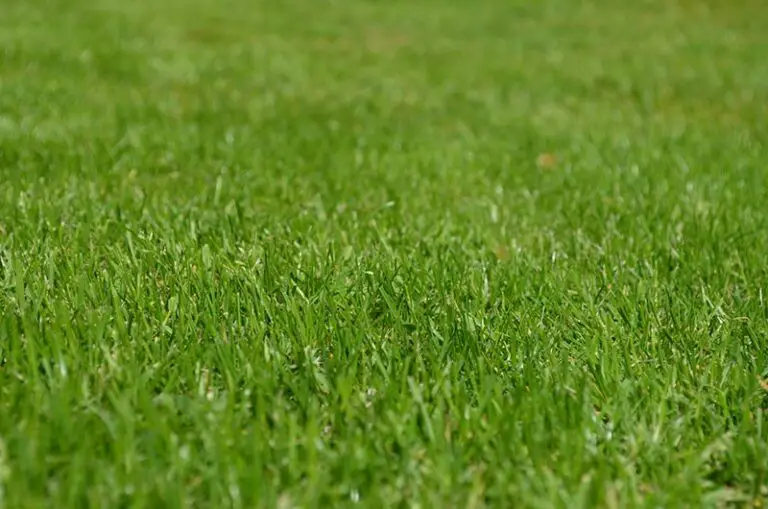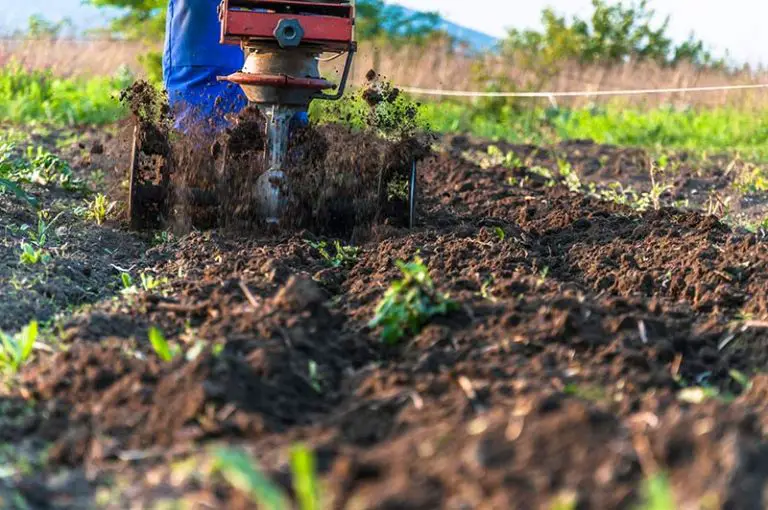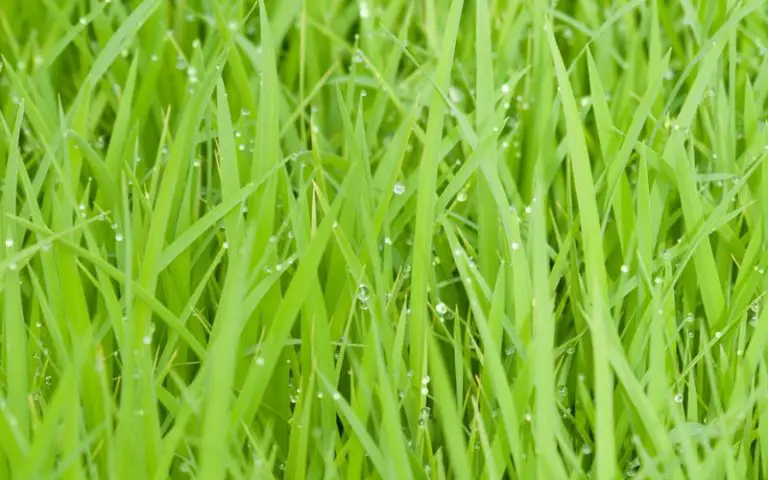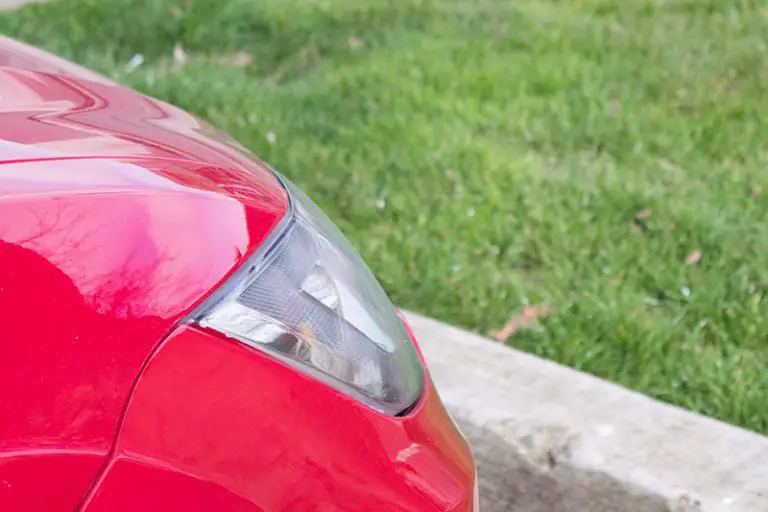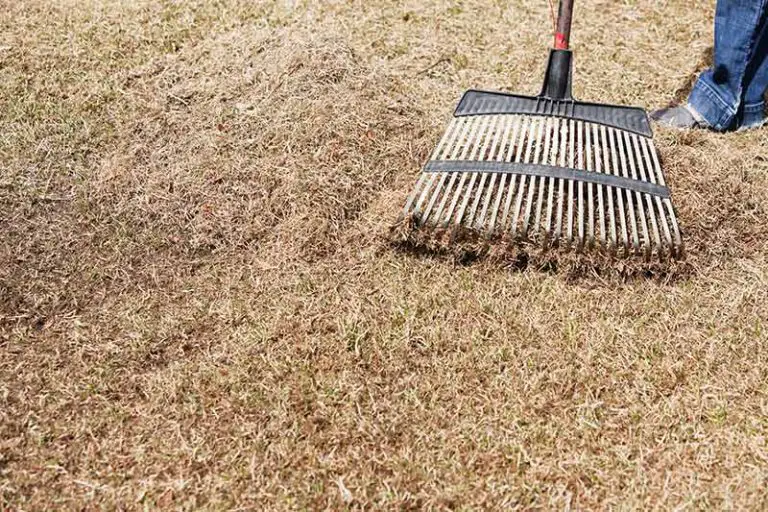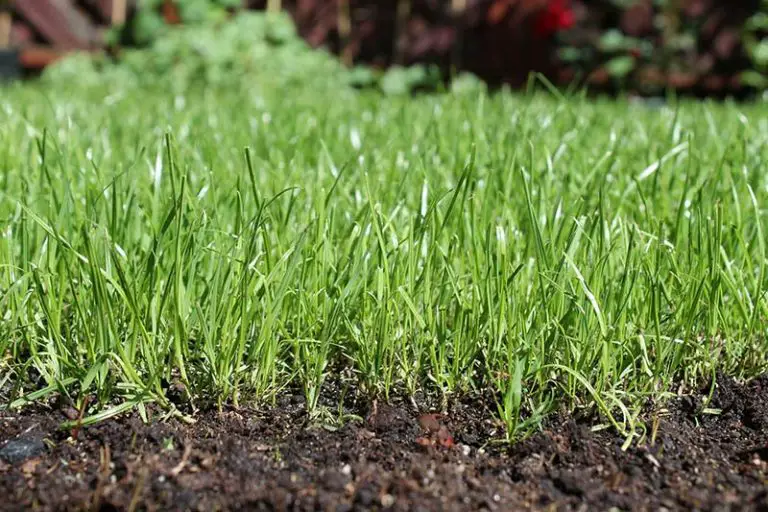Holes In Yard: Causes And How To Repair Your Lawn
It can be quite frustrating to have your well-dressed lawn disturbed by unsightly holes. Some of these holes appear overnight as if by magic, while others appear at certain times of the year. What causes these holes in your lawn or yard, and what is the best method to repair your lawn?
Holes in your lawn can be the activity of burrowing animals, insects, pets, or children. It could also be from activity on your lawn or subsiding ground. Treatment for holes in the lawn should start with a diagnosis of the cause and prevention methods. Fill the holes with a 1:1 potting mix and sand.
If you notice holes beginning to appear in your lawn, you need to put on your detective hat and start an investigation before taking steps to close the holes. Some holes may indicate an underlying problem that should be addressed before further damage to the lawn occurs. We will also show you the right way to repair the holes in your lawn.
What Causes Holes In Your Lawn?
The causes for holes in your lawn are varied and diverse, and identifying the cause of the holes is the first step to rooting out the problem and preventing more holes from appearing.
The remedy needs to match the cause, so it is important to find out the cause for the holes. Many gardeners immediately assume that holes in their lawn result from a critter, but in some cases, it could be a soil structure problem.
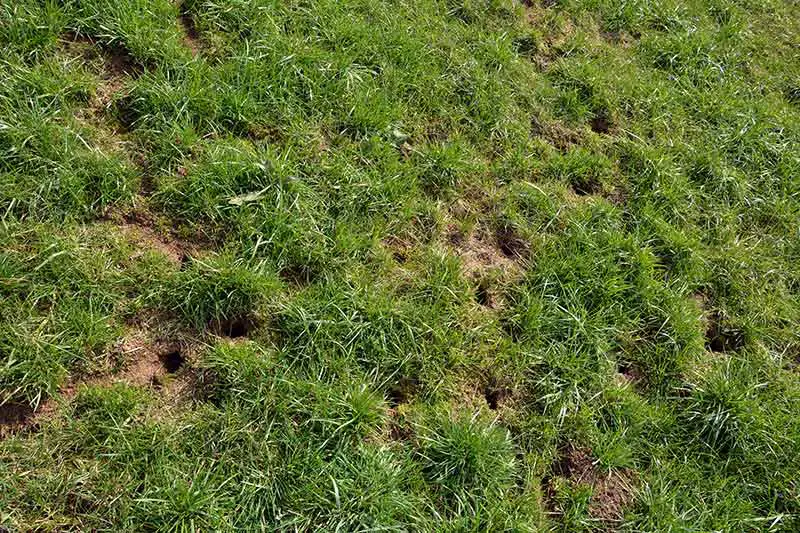
The main causes for holes in your lawn include the following:
- Burrowing insects.
- Worms.
- Burrowing animals and rodents.
- Pets
- Children
- Traffic on your lawn and soil subsidence
Establishing which problem is the cause of the holes in your lawn will put you on the right track to solve the issue and prevent it from damaging your lawn further.
Some of the causes for holes in lawns are beneficial to the grass. In these situations, you would not want to eliminate the cause but rather only fill in the holes to prevent them from getting larger or being used by other critters.
Let’s examine each cause, identify if it requires steps to remedy, and what you should do to sort out each problem. Finally, we will show you how to fill the holes in your lawn the right way to promote fast recovery of the grass.
Examine The Size Of The Holes
The size of the holes is the first step in your investigation to find the perpetrator! Small holes are usually the work of insects, worms, or birds.
Slightly larger holes are usually the work of smaller rodents such as rats and mice or voles. Holes with a mound of conical-shaped loose soil over the top of it are the work of a mole. Larger holes with dirt scattered around the hole’s perimeter are probably a pet that has excavated the hole, and claw marks are usually evident.
Children can dig holes to play in, which are usually evidenced by some toys or digging implements left at the scene of the crime, or kids riding bicycles on wet grass can cause ruts or areas of subsidence. These would appear more as hollows rather than holes.
Natural subsidence of the soil can also appear as holes in your lawn. There will be no sign of soil scattered on the outside of the hole since the ground would have collapsed inwardly.
Holes In Lawns Caused By Insects And Worms
Smaller holes in lawns are usually caused by insect activity or by worms, and not all of these holes are detrimental to your lawn.
Earthworms will sometimes come to the surface and leave a small hole, but these holes work to aerate the soil and are beneficial to your grass. The excrement or cast of the earthworms is also a good natural fertilizer for your grass. For earthworm holes, simply cover the holes with potting soil and sand in a 1:1 ratio and rake it over the area to level it off.
Other insects, such as Japanese beetles, can be more problematic for your lawn. This is an invasive species that can decimate your lawn and other plants in your garden. The beetles lay their eggs in holes in well-irrigated lawns. The larvae burrow under the lawn and eat the roots of the grass, causing bare patches.
The holes appear when the adult beetle emerges in early July to feast on other plants in your garden. Predators who eat the Japanese beetle larvae, such as birds, skunks, and raccoons, will dig holes in your lawn searching for these tasty treats.
Reduce irrigation of the lawn in late June and early July to limit the attraction of the beetles to your lawn. If you get an infestation, it is best to seek professional pest control measures as the insecticides used to control these pests are highly toxic, even though they can be purchased over the counter. Alternatively, you could attempt to get rid of them yourself following the guidance in our article Signs of Lawn Grubs.
Holes In Lawns Caused By Burrowing Animals And Rodents
Several animals could cause holes in your lawn. We will discuss the most likely animals that would cause problem holes in your lawn and what you can do to prevent the problem from getting out of hand.
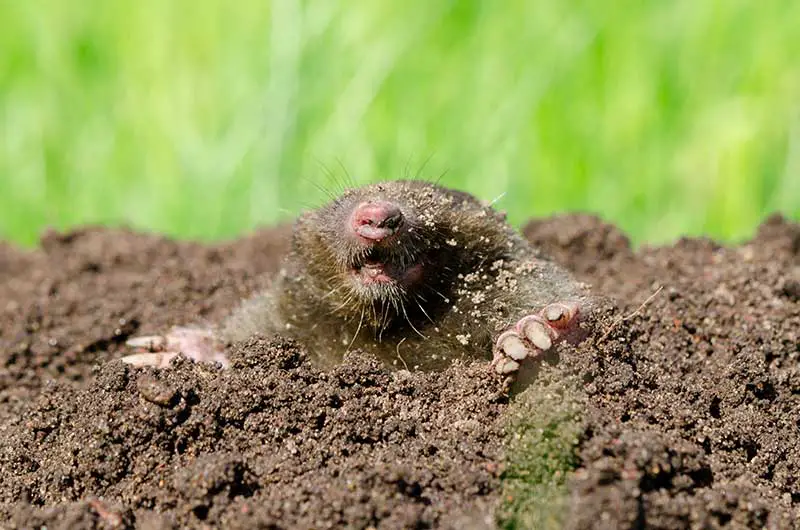
Holes In Lawns Caused By Voles
A vole is a small rodent that looks similar to a field mouse but is more stout and has a shorter, hairy tail like a cross between a rat and a mole. They are more closely related to hamsters and lemmings than they are to rats and mice.
Voles are burrowing rodents, and the main danger to them proliferating in your garden is that they eat vegetation, especially the underground roots of your lawn!
Voles dig shallow tunnels under your lawn about 2-inches in diameter. You may notice the grass above the vole tunnels deteriorating due to roots in those areas being cleared in the tunnels or eaten by the voles. Voles are most active in springtime, which is when you will see these holes appear and degradation of the lawn along the tunnel routes.
The taste and smell of castor oil are distasteful to voles. Pouring some castor oil down their holes and along their trails may give them the message that it is time to relocate. They also do not like hot chilies and peppers. Chop up some hot peppers and sprinkle around the holes, or mix with water in a spray bottle.
Rats And Field Mice In Your Lawn
Rats and field mice may take residence in old vole holes as a safe refuge to sleep and breed. This rodent problem needs to be addressed quickly because rats and mice are prolific breeders, and you may have an infestation on your hands if you leave it too long.
Rats and mice like plenty of cover, so make sure you keep the grass short and trim any ground cover or low plants near the holes. If the rodents do not relocate, your best route is to call a pest control company, but be sure to tell them to use pet-safe and environmentally safe measures to address the problem.
Moles In Your Lawn
Moles can actually be a beneficial creature to have in your lawn, other than the unsightly holes they dig up. Unlike voles, moles are carnivorous and do not eat your lawn or your plants. They eat worms, beetles, and other insect larvae that could be detrimental to your grass.
Moles also dig deeper holes than voles, making their tunnels less unlikely to interfere with the roots of your lawn or other plants.
Moles can be deterred by planting marigolds, garlic, daffodils, shallots, or alliums around the perimeter of your lawn and in any beds on your lawn. Moles do not like these plants and will avoid areas where they are planted. You can also use a commercial pet-safe mole repellant.
We have gone into more detail about methods of mole elimination in our article How to Get Rid of Moles.
Pets Causing Holes In Your Lawn
Dogs and cats can cause holes in your lawn. These pets dig holes for entertainment, to hunt, or because the breed is predisposed to digging. They could also dig holes to lie in the cool soil or curl up in a hollow to keep warm.
Dogs such as terriers have been pred to dig as part of their hunting instinct. If your dog notices a hole or a rodent burrow in your lawn, they may try to dig it up to hunt the rodent.
While it is almost impossible to totally eradicate the digging behavior in your pet, you can try to curb the behavior by giving your pet more attention. Placing a sensor-driven sprinkler system in areas where you do not want the dogs to dig or sprinkling citrus fruit peels over the area can also work as a deterrent.
See our article How to Grow Grass With Dogs for tips on having a healthy lawn that can be enjoyed by you and your pet.
Holes In The Lawn Caused By Children
Fortunately, children are easier to train than pets. Children can cause holes in your lawn by digging as part of their playtime or hollows caused by ruts from riding bikes on a wet lawn.
Create a designated digging area for your children, such as a sandpit, and explain that this is the only area in the garden where they may dig. Teach your children not to ride their bikes on the lawn just after rain or irrigation. The tires will sink into the wet sod, causing ruts which will cause hollow sections in your lawn.
Holes Caused By Traffic And Soil Subsidence
When the lawn is wet, it is most susceptible to heavy traffic, compacting certain grass areas, causing ruts. Likewise, heavy vehicles driving on the grass, such as deliveries of topsoil or compost, will cause ruts in the grass from the delivery trucks.
Where possible, prevent heavy traffic over the lawn when it is wet. Schedule deliveries for later in the day once the grass has had time to dry out.
Soil subsidence can also cause hollows or even holes in your lawn. There are hollow pockets in the soil, where vegetation may have rotted away, a clump of hard soil dissolved, or a piece of trash under the soil disintegrated, leaving pockets in the soil.
Should the pocket collapse, it can appear on the surface as a hole or indentation in the lawn. These holes cannot be prevented and should simply be repaired as they appear through leveling and grading. These holes are unlikely to be frequent or become problematic to your lawn.
What Causes Small Holes In Lawn Overnight?
Waking up to a lawn full of small holes is a sign that something has been busy in your yard throughout the night. These small overnight holes are created by creatures that are nocturnal; in other words, animals that sleep during the day before coming out at night to search for food or shelter.
Some of the creatures that specifically create small holes in your lawn overnight include:
- Raccoons and skunks
- Rabbits
- Rodents
Raccoons and Skunks
Raccoons and skunks are two of the most likely culprits for causing small holes in a lawn overnight. While these animals are sometimes seen during the day, they are typically nocturnal creatures and will scour your lawn for food at night. When searching for grubs and other insects, skunks make small shallow holes in the loose topsoil in your lawn. Raccoons, on the other hand, use their front paws to actively search the soil for food by flipping over sections of turf. These are two highly destructive animals that are likely the cause of the small holes that appear overnight.
Rabbits
While rabbits aren’t nocturnal, they are a burrowing species that can seemingly cause small holes in your lawn overnight. They don’t strictly operate during the day, often being active at night to dig holes in your yard undetected by their daytime predators.
Rodents
As we’ve already discussed, rodents are a common cause of small holes in a lawn. Many types of rodents are most active in the evening or overnight. Rats, for example, are an entirely nocturnal species – they will dig up your lawn at night hunting for food. Mice aren’t strictly nocturnal, however, they are most active at dusk and dawn when the least danger is present from their predators. Again, this is why small holes may seem to appear in your lawn overnight.
How To Repair Holes in Your Lawn
Irrespective of how the hole occurred in your lawn, fixing it the right way will help the lawn recover more quickly and cover up the affected area.
The best time to fix holes in your lawn is when the grass is in its most vigorously growing stage, which is usually late spring for grasses that grow in warm seasons and early fall for cool-season species of lawn. When the grass grows vigorously, it will quickly spread to cover bare spots in the lawn caused by the holes.
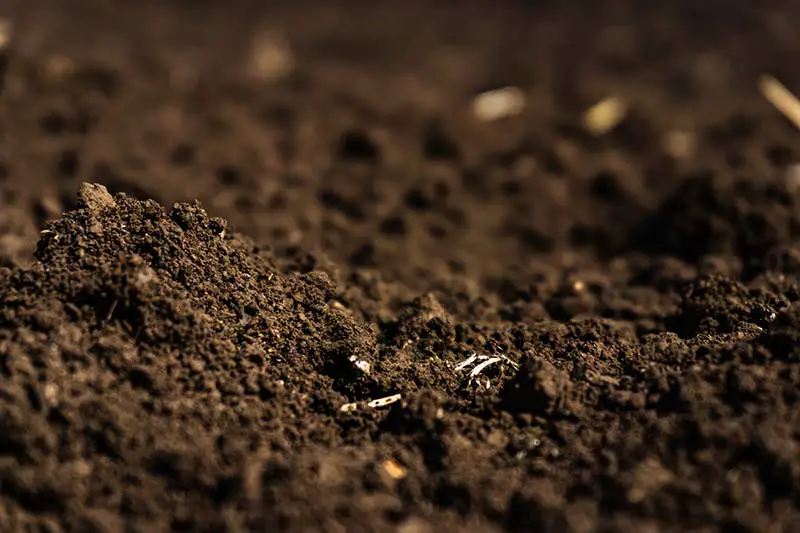
Prepare A Lawn Hole Fill Mix
You will need a growing medium to fill the gap left by the hole and encourage the grass to grow over the spot.
A mixture of topsoil and potting soil in a 1:1 ratio provides a good loose mixture to allow the lawn roots to penetrate the fill, and the nutrients provided in the potting mix promote fast growth of the lawn.
Mix the soil and potting mixture thoroughly to ensure the even distribution of both ingredients throughout the mix.
How To Fix Small Holes In Your Lawn
Fixing small holes in your lawn is very easy. Fill the hole as much as possible with the fill mixture, and then simply spread your fill mix over the affected area and even it out with a rake.
You can leave the mixture slightly raised over the area immediately over the hole. As the soil subsides, it will naturally level out.
How To Tix Medium-Sized Holes In Your Lawn
If there is lawn growing close to the hole, cut a patch or the lawn so you can fold it up to one side while you fill the hole.
Fill the hole with your fill mixture to a height of 1 to 2-inches above the surrounding soil. Fold the patch of lawn back over the repaired area.
If there was no grass over the hole, cover the hole with your mixture and overseed the area. You can transplant a piece of sod from elsewhere in your garden to cover the bare area of the hole as an alternative.
How To Fix Larger Holes In Your Lawn
Fixing large holes will require a bit more work to fill and cover. If the hole is deep, start by filling the hole with broken bricks or stones to fill the bottom half of the hole.
Place sand on top of the stones, filling the hole to about a third from the top. At this point, add your fill mixture as a top layer as a growing medium for the lawn.
Once the hole is full, spread some of the mixture around the hole to where it intersects strongly growing grass. Water the mixture in and add more of the mixture if the level of the soil drops.
Plant lawn runners over the soil or sod relocated from elsewhere in the garden. Overseed the area as well to ensure a thick growth over the affected area.
How To Fix Ruts In Your Lawn
Ruts in your lawn can be fixed similarly to holes, using the same hole fixing mixture as before. If the rut has grass growing in it, chop it in a centerline down the middle of the rut, and lift the two pieces of grass to the left and right of the rut.
Fill the hollow of the rut with your mixture to raise it above the surrounding ground level by about 1 to 2-inches. Fold the grass back down over the area and water it in.
If there is no lawn in the rut, fill the rutted area with the fill mixture and re-seed the area. You can also transplant grass from other areas of your garden to fill the area in faster.
Conclusion
Discovering holes in your lawn can be a disheartening experience, especially if you have put a lot of time and effort into improving your lawn.
Fortunately, most of the causes for holes in your lawn can be easily addressed and the holes repaired without too much difficulty or inconvenience. Repair the holes correctly, and your lawn will soon be back to its usual luscious growth!

